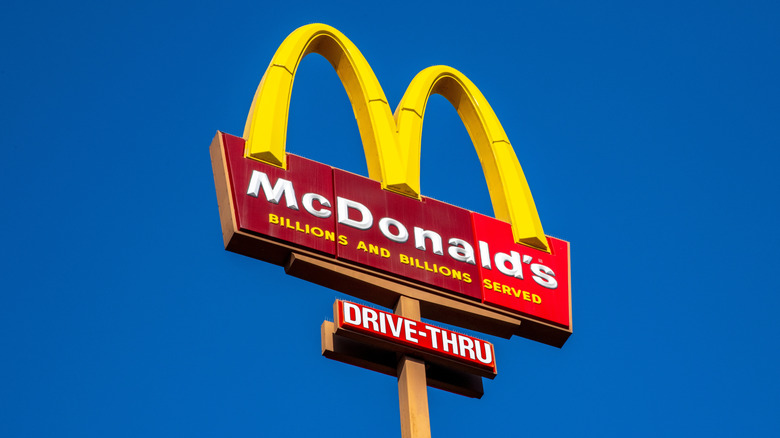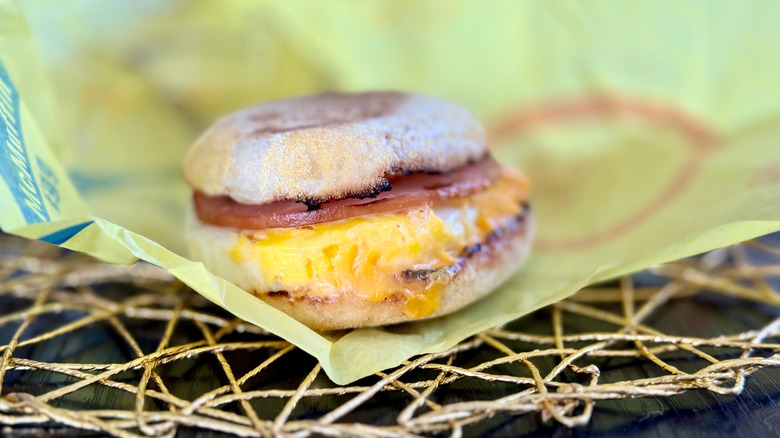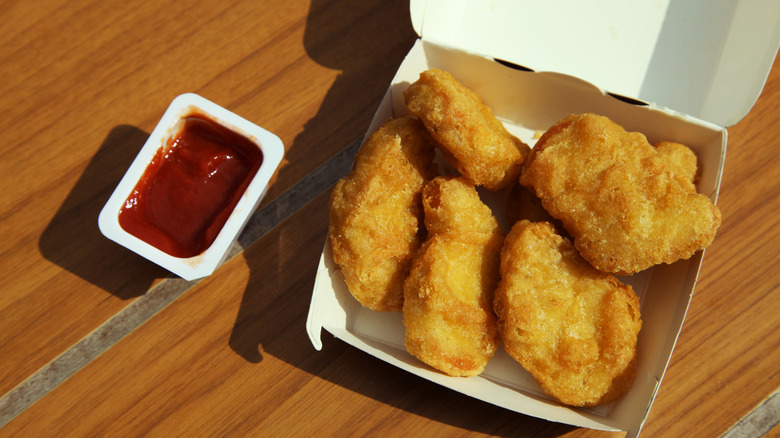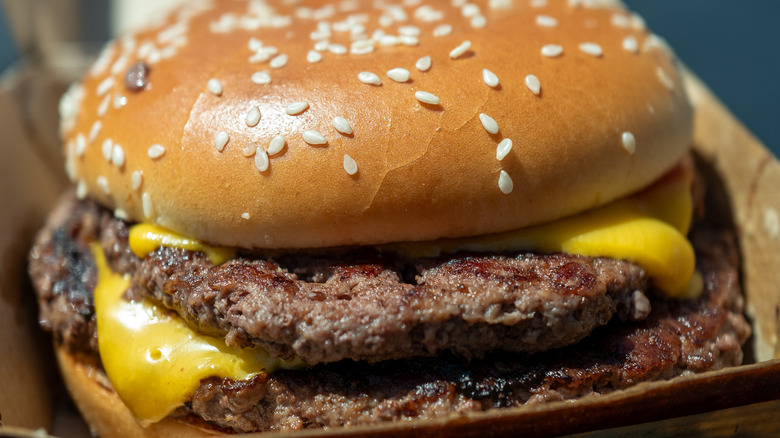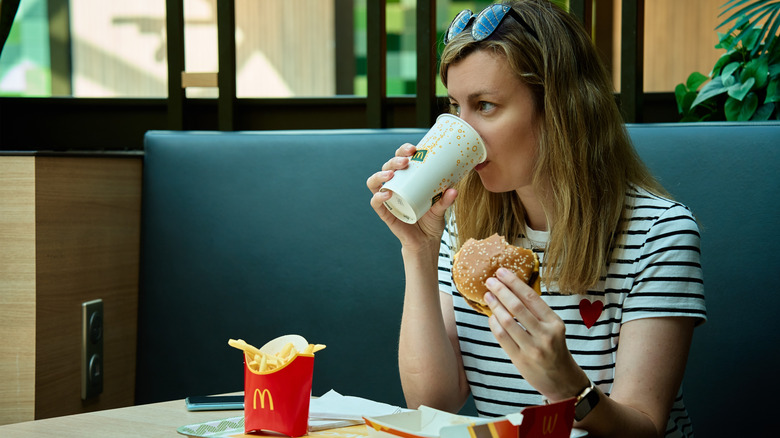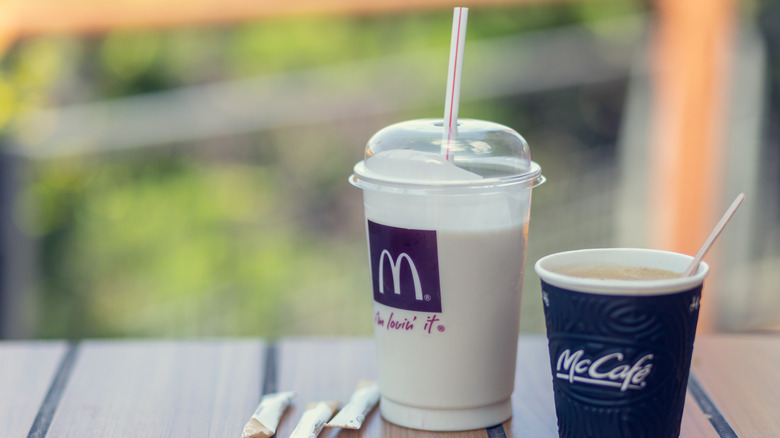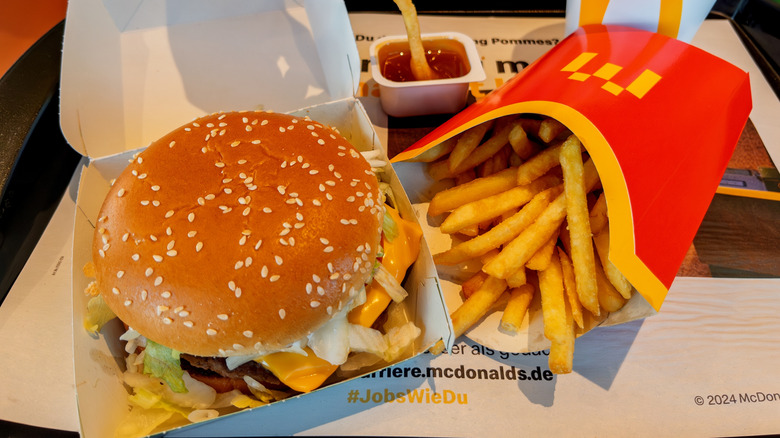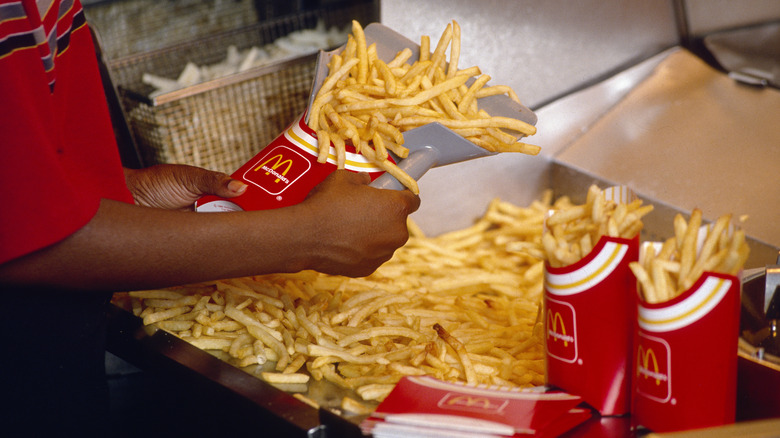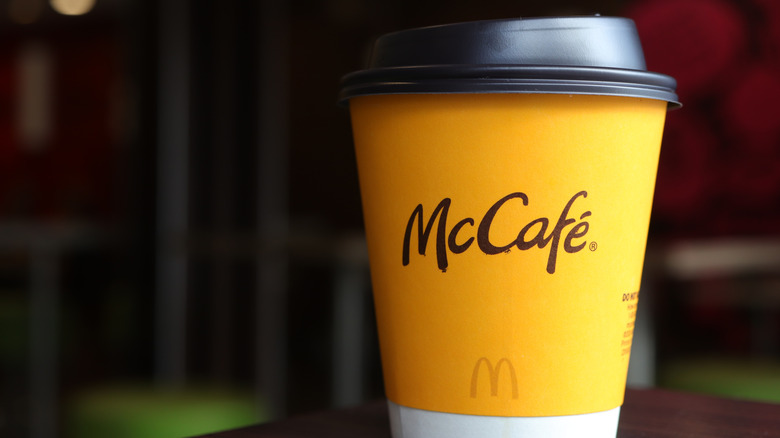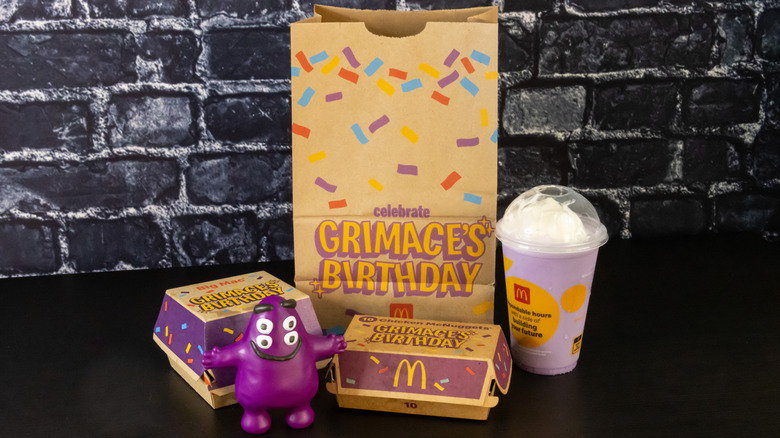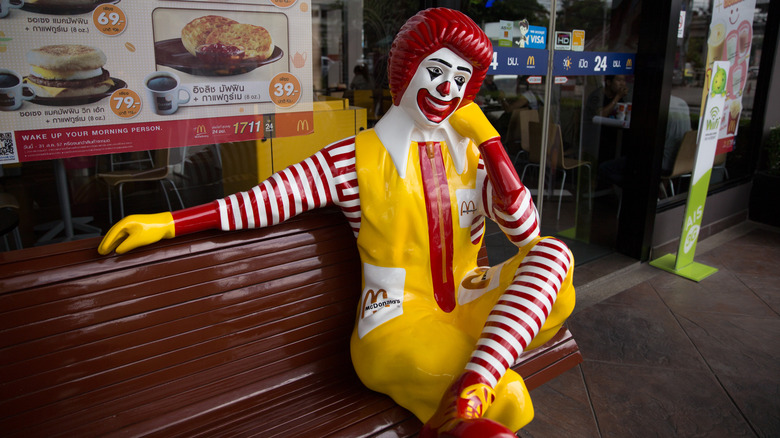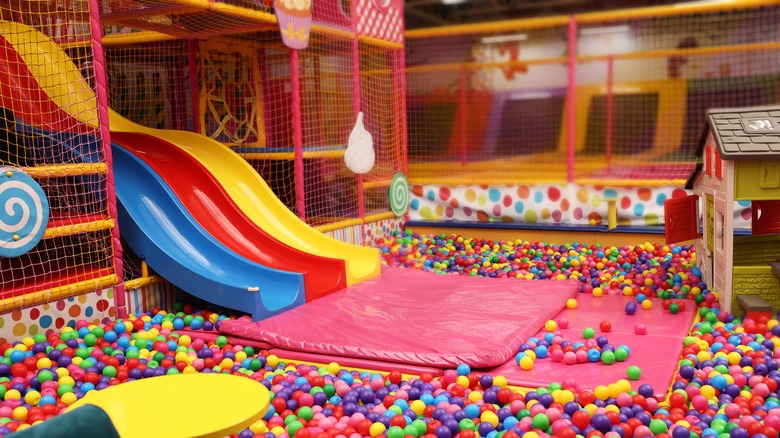11 Cliché McDonald's Myths That Need To Go Away Forever
One of the oldest fast food restaurants to exist is — you guessed it — McDonald's. Whether you've come to love or hate the joint, there's no point in arguing the fact that people grew up on the chain's affordable menu since it first opened in 1940. Nor can anyone deny that its presence has lasted through succeeding generations. But over those many decades, McDonald's famed reputation has come at a price — a plethora of urban legends.
With the number of McDonald's around the world in 2024 hitting a bit over 43,000, it's almost expected that the chain would somehow fall victim to countless rumors created by its extensive consumer base. But the absurdity of some of these myths, from the ingredients it uses to the effects its food will have on you, and how they've managed to persist for so long, is what's striking. It's about time that the following folk tales be put to an end so some of us can enjoy our floppy Big Macs and overly-salted fries in peace.
Plastic eggs are used in the Egg McMuffin
Nothing is ever really safe from criticism at McDonald's. Not even its humble Egg McMuffin, the order that came out on top in a ranking of every McDonald's breakfast sandwich. These McMuffins come with a rotation of staple ingredients, such as bacon and sausage, depending on which one you choose to get. What stays consistent from order to order is the egg, which customers eventually began to claim looked plasticky, likely on account of its shiny appearance and perfectly round shape.
The chain shut down people's assumptions by saying it uses real, USDA Grade A eggs in all of its breakfast menu items, including its classic Egg McMuffin. It also said that the egg is "cracked into an 'egg ring' to get that iconic round shape." McDonald's U.K. even released a short, cheeky video affirming this, as the voiceover definitively declared "There's a real, freshly cracked, free-range egg in every McMuffin" at the end of the ad.
McNuggets contain pink slime
In addition to the joint's famous fries and signature Big Mac burger, McNuggets are among Mickey D's most popular — and scrutinized — menu items. The chicken nuggets are generally well-loved today for their crisp outer layer and tender inside. But over the decades, starting in 2004, the McNuggets have been accused of being made with mechanically separated meat, also known as "pink slime."
One of the many fast food ingredients that should send you running, mechanically separated meat refers to the meat that's been isolated from the bones of the animal it was once attached to, which is achieved by putting the bones through a high-pressure device. Ammonia is then used to kill off any bacteria. While the use of ammonia in very small amounts is considered generally safe when it comes to food processing, it's important to note that the chemical itself can present side effects like wheezing, difficulty swallowing, skin irritation, and more.
It's not completely off base for the public to be wary of McDonald's using this chemically-treated protein. After all, it used to — mechanically separated meat was indeed used in the establishment's nuggets up until 2003. The Golden Arches restaurant has since then said that its entire menu now only uses "carefully deboned chicken breast meat, never Mechanically Separated Poultry." So, the photo of a tub of mysterious-looking pink slime that keeps resurfacing on the internet? Don't believe it when people say it's from behind the scenes of the McNugget making progress. Even McDonald's has said there's no connection.
McDonald's doesn't use 100% beef
People really don't want to see McDonald's win, and it shows. Even when the corporation has delivered what the public wants by using real ingredients in its food, people have chosen not to believe it and instead resorted to far-fetched conspiracies to discredit it. Case in point: The chain advertised its burger patties as "100% beef," and an unconvincing theory sprouted up that this is actually the name of a company owned by the fast food giant. Hence, McDonald's can then cleverly slap those words onto its products while getting away with using fake meat all the while.
McDonald's shut those rumors down in 2018 when it confirmed that they're false. The phrase "100% beef" thankfully means exactly what we would hope, which is that the establishment uses whole cuts of beef to make its burgers. And no, cow eyeballs are not a part of that, since people seemed to believe that was a sure thing before, too.
Human meat is in McDonald's food
If you thought the world was getting tired of McDonald's and fearing for their lives every time they took a bite out of a Big Mac, just know McDonald's must've been getting real tired of everyone, too. Because having to fight off pink slime allegations in its McNuggets is one thing, but needing to reassure the world that human meat isn't in its burgers is a whole other level.
That's exactly what the eatery had to do when, in 2014, a blog jokingly asserted that human remains were discovered in the freezers of an Oklahoma City McDonald's as well as most of the chain's other factories. Lo and behold, the rumor spread like wildfire, and it wasn't long before people misconstrued the satirical website and treated the myth as fact. Things got even worse when more lore was added to the folktale, and it was said that the chain's locations closed in three different countries for serving human meat. McDonald's took to the "Your Right To Know" section of its website to debunk the lies.
The shakes have pig fat
Offering chocolate, vanilla, and strawberry flavors, McDonald's shakes are thick, creamy, and delicious. What, exactly, gives these sweet treats their rich flavor and smooth texture? As falsely spread on the internet, the answer would be pig fat. This idea has been debated as early as 2006, but it was in 2018 that McDonald's flat-out said that the drinks contain zero meat products and are thus safe for vegetarians.
What fuels the rumor mill even more is the fact that McDonald's calls its drinks "shakes" rather than "milkshakes." A bit more understandably, people assume that the omission of the word milk is because the drink doesn't actually contain any of the dairy product, and rather, McDonald's uses random fillers (like animal fat). That's not the case, though. The chain's shakes do contain milk because they're made using soft-serve ice cream. McDonald's chose to call the sweet treats shakes to keep things as uncomplicated as possible since what constitutes a drink as a milkshake varies depending on the state you're in.
The burgers and fries don't rot because they're loaded with preservatives
There are a lot of facts about Burger King's Whopper you may not have known — one of them being that its successful Moldy Whopper campaign, which showcased the growth of mold on the sandwich over the span of a month, was created to differentiate itself from other fast food restaurants. In particular, Burger King was taking a jab at McDonald's, which was receiving a lot of heat at the time for its burgers and fries that seemingly never decomposed.
Backlash toward Mickey D's started when people shared stories of how their orders simply never went bad. For example, one woman was able to use the same McDonald's burger for over a decade as a prop in her educational class. The same goes for a man who purchased a burger and fries, both of which looked fresh even after six years had passed. How? Because the chain pumps its food so full of fake ingredients and preservatives, of course, the masses cried.
That's not the case, though. McDonald's has said that none of its burgers contain artificial preservatives or fillers (aside from the added pickle slices). The reason the food seems to never rot is because it becomes so dried out that there's not enough moisture for bacteria or mold to even grow. That being said, take a bite out of your month-old sandwich (please don't actually), and you'll see it's nowhere near the same quality as when you first ordered it.
Eating its fries can get you pregnant
There are lots of reasons to indulge in McDonald's world-famous fries. They're crispy, salty, and affordable. Oh, and they can help get you pregnant, too. At least that's what some women believe when they turn to eating the starchy snack right after having intercourse.
The birth (no pun intended) of this superstition likely comes from the fact that doctors suggest those experiencing ovarian hyperstimulation syndrome (OHSS) up their salt intake. OHSS is a condition in which liquid may build up in women's ovaries and leak out into other parts of the body as a result of the egg retrieval process that happens during fertility treatments. Part of the purpose of sodium is to help your body absorb all that extra fluid.
Hence, the idea that eating McDonald's fries, which are made with 190 milligrams of salt in every small bag, would increase the chances of a woman's body holding onto substances of the baby-making type. Despite a decent number of people who actually use this method, there's no real evidence linking McDonald's fries to a higher possibility of conceiving. Still, self-care is important in any case, so there's no harm in reaching for that carton of fries regardless of what the science says.
McDonald's gave over $1 million in the hot coffee lawsuit
McDonald's serves all-day coffee that most people can't get enough of. Its typical price range of $1 to $2 makes it hard to beat, and that's not even getting into the other factors that make it taste so good, like the specially made blend it uses. McDonald's also attributes part of the drink's deliciousness to the temperature it's served at — somewhere between a scalding 180 and 190 degrees Fahrenheit.
This high level of heat became the central point of discussion in a 1992 legal case, in which a customer named Stella Liebeck suffered third-degree burns after spilling a cup of McDonald's coffee on her lap. She racked up a hefty hospital bill, and as a result, the fast food giant was fined $2.7 million in punitive damages. This number was later drastically lowered to $480,000, which both Liebeck and McDonald's appealed. The two sides ended up settling for an unrevealed sum outside of court instead.
The media had an absolute field day with this lawsuit, generating inaccurate headlines that McDonald's, in fact, coughed up almost $3 million over a cheap cup of joe. No one knows just how much the company actually ended up paying, but it's safe to say it couldn't have been anywhere near that amount since the fine had already been significantly reduced even as the case was going on.
The Grimace Shake will kill you
We all know Ronald McDonald as the face of the Golden Arches. However, real fans know he once had a whole crew of rag-tag friends that he lived in McDonaldland with. We won't blame you for not being familiar with most of the characters since they were phased out of the establishment's marketing in the early 2000s. But even today's generation is familiar with Grimace, the fuzzy, purple blob, who returned in 2023 and stole our hearts — and, apparently, ruined a whole lot of stomachs.
That year, a berry-flavored drink called the Grimace Shake was released in honor of the character's 52nd birthday. Well, Grimace probably won't ever want to celebrate his birthday with any of us again, and we don't blame him. Following the beverage's debut, a TikTok trend went viral in which people would take a sip and pretend to die or become seriously ill.
While the videos were clearly satire, and it's unlikely that many people believed it, it's hard not to want the myth to be fully wiped from the internet for Grimace's sake. All the poor guy wanted was to celebrate his special day after a long hiatus from McDonaldland, and instead, this is what he was met with. Hopefully, the shake will make a return so the world can bring Grimace some justice. Users on Reddit have shared similar sentiments, with one user saying, "I was overcome by an insane burst of empathy for Grimace after the TikTok trend. I'm a grown man tearing up about a purple monster and his milkshake."
McDonald's organized the killer clown scare in 2016
A lot of things defined the year 2016: Trump's first election, Beyonce's release of her award-winning album, "Lemonade," and the rise of Snapchat and the dog filter no one could take a selfie without. And how can we forget the few months when people dressed in clown costumes went around terrorizing victims with knives? Ronald McDonald sure won't forget it, as it's due to this crazy period of time that his appearance in the chain's marketing has diminished.
In a statement to CNN that year, a spokesperson of the establishment said that, "McDonald's and franchisees in local markets are mindful of the current climate around clown sightings in communities and as such are being thoughtful with respect to Ronald McDonald's participation in community events for the time being." There may be a lot of mistakes made throughout McDonald's history, but this isn't one of them. It was a good move, as in all the hysteria, some people began to point fingers at the corporation, suspecting that McDonald's orchestrated the whole clown craze.
This fear was likely a result of old Japanese commercials that resurfaced, featuring Ronald McDonald doing creepy things like relentlessly trying to get through someone's locked door, waiting outside a woman's window, and later hiding under her bed. McDonald's didn't say anything to outright quash the suspicions this caused, but it's important to note that the seemingly damning commercials came out years before the clown sightings occurred, which should have been enough to hush the unlikely myth of McDonald's involvement.
A boy died from a heroin needle in a McDonald's PlayPlace
There are many things you probably didn't know about McDonald's PlayPlaces, like that you can still book birthday parties there today and that the first designs of these areas were called McDonaldland Playlands. Or, maybe, you didn't know McDonald's had play areas at all, considering there are many fewer restaurants around that actually still have them. But for those who are familiar with the jungle gyms, you've likely heard the tragic, widespread story of a 3-year-old boy who was pricked with a hypodermic needle lurking at the bottom of a McDonald's ball pit, which led him to overdose on heroin and pass away.
To the relief of parents and surely the Golden Arches corporation, it was all a hoax – a somewhat plausible one, at that, with how detailed the mother's retelling of the incident was. Nonetheless, McDonald's has addressed the situation, saying no deaths related to the PlayPlace have been reported or confirmed to have actually happened. There is, unfortunately, truth, however, in needles and other dangerous, unsanitary items being discovered at various McDonald's play areas. Not only did a young girl actually have to visit the emergency room one time after getting nicked by a needle, but things like dirty diapers, leftover food and condiments, and, supposedly, a pair of rusty scissors have been reported at PlayPlaces.
